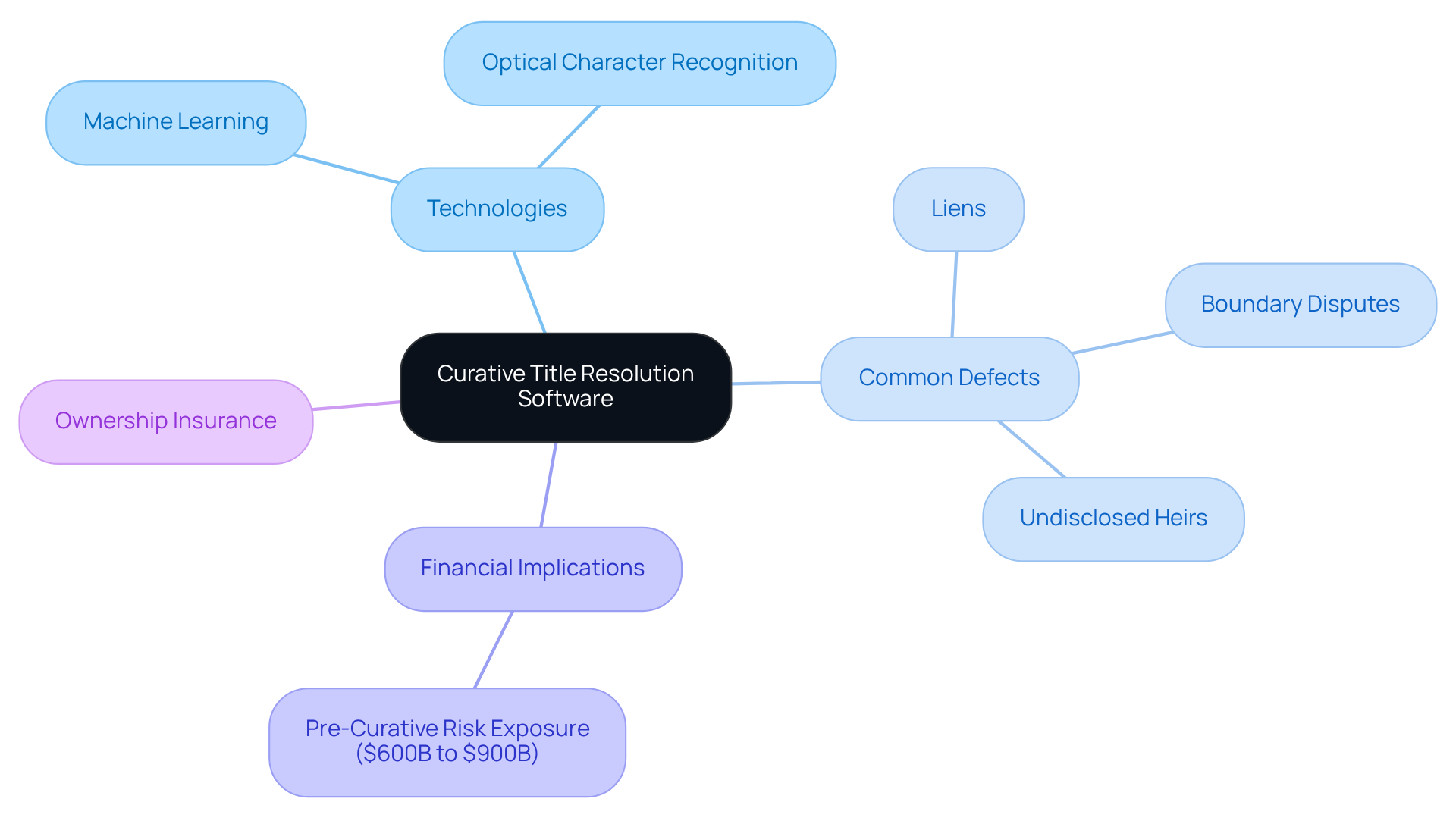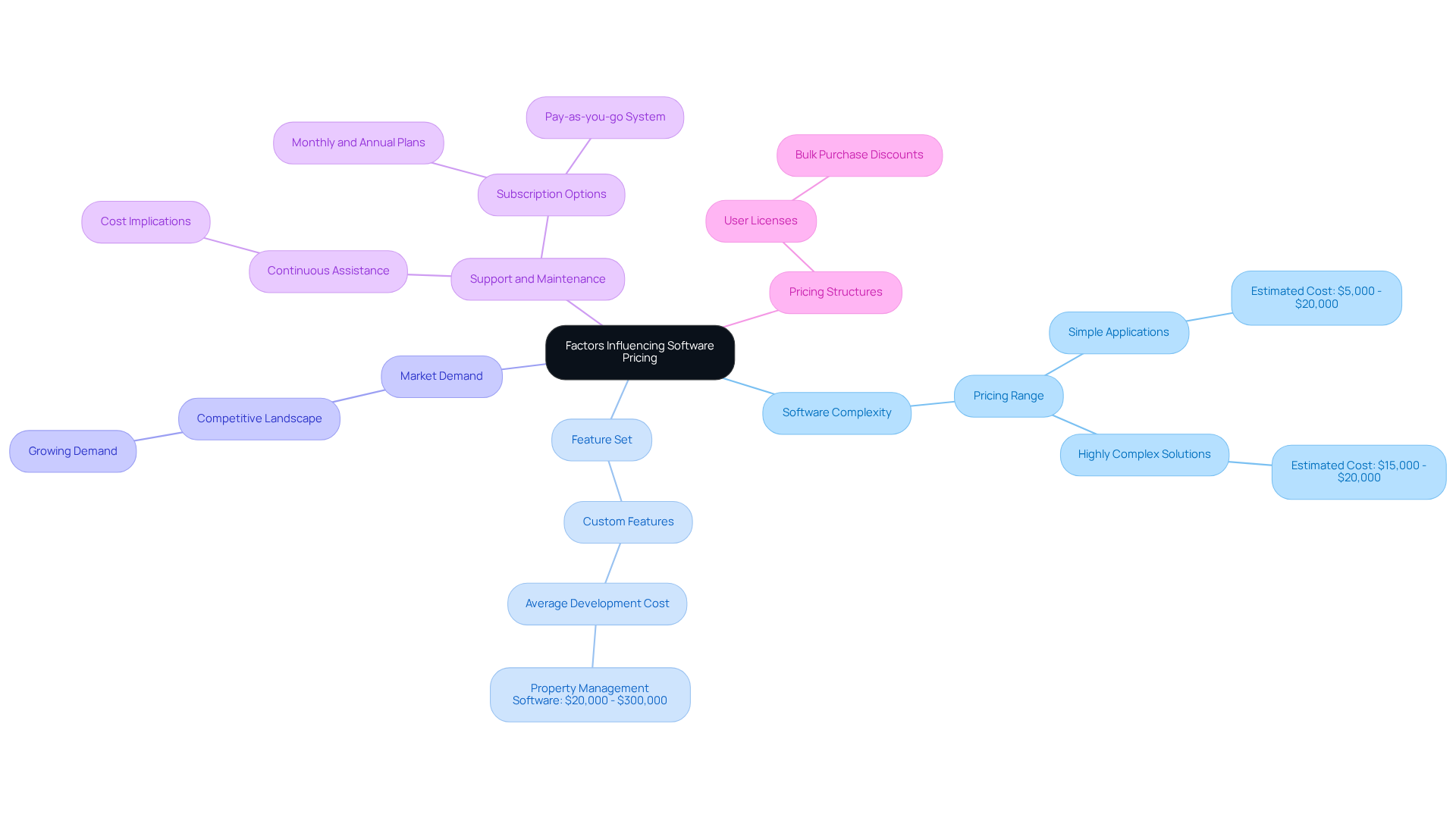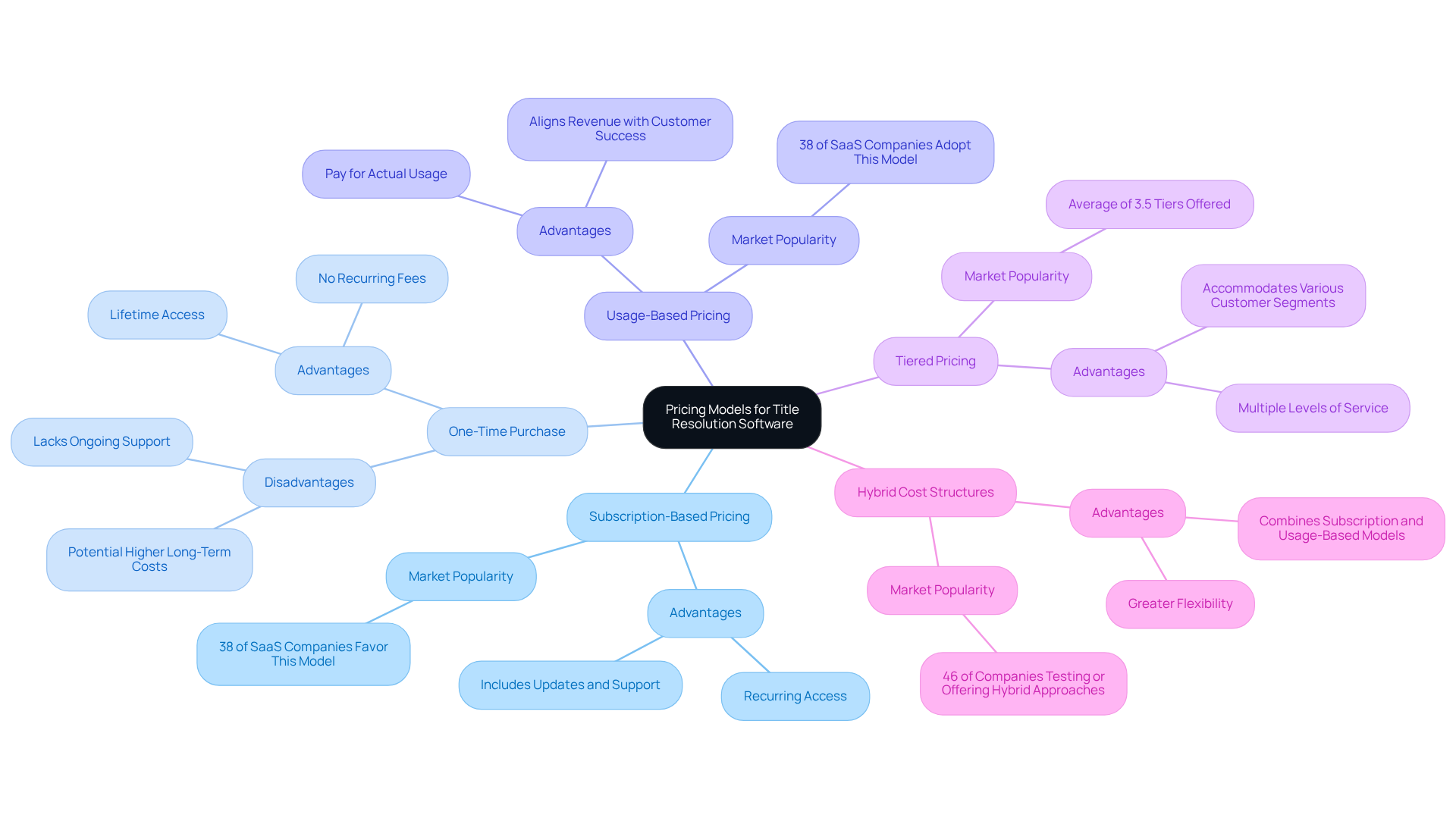Overview
This article delves into the intricacies of curative title resolution software pricing, emphasizing the critical factors that shape costs and the diverse pricing models available in the market. The complexity of the software, the range of features offered, market demand, support and maintenance requirements, and user license stipulations significantly influence pricing. Furthermore, it outlines various models such as:
- Subscription-based
- One-time purchase
- Usage-based pricing
Each model is designed to accommodate distinct business needs and budgetary considerations.
Introduction
Curative title resolution software stands at the forefront of modern real estate transactions, playing a crucial role in ensuring that property ownership remains clear and marketable. As the demand for efficient solutions grows, understanding the pricing dynamics and models associated with this technology becomes essential for industry professionals.
Furthermore, with various factors influencing costs—from software complexity to market demand—businesses must navigate this landscape effectively to identify the best fit for their needs.
Explore the Fundamentals of Curative Title Resolution Software
Curative ownership resolution applications are pivotal in identifying and rectifying defects in property documents, thereby ensuring that possession remains both clear and marketable. By leveraging advanced technologies such as machine learning and optical character recognition, these applications optimize the examination of document titles. Automation facilitates the rapid extraction of essential information from extensive record collections, significantly enhancing both the pace and precision of research.
Common ownership defects—such as unresolved liens, boundary disputes, and undisclosed heirs—can complicate property transactions, emphasizing the critical importance of curative title resolution software pricing. Furthermore, the sector dealing with property deeds faces considerable pre-curative risk exposure, estimated between $600 billion and $900 billion annually prior to the pandemic, highlighting the urgent need for effective curative solutions.
Ownership insurance also plays a vital role in safeguarding against , ensuring that properties remain marketable. As the real estate market evolves, a clear understanding of these fundamentals empowers professionals to effectively leverage these tools, facilitating smoother transactions and fostering greater confidence in property ownership.

Identify Key Factors Influencing Software Pricing
Several factors significantly influence the pricing of curative title resolution software:
- Software Complexity: Advanced software solutions with sophisticated features generally command higher prices. The intricacy of the program correlates with the development effort and resources needed, with curative title resolution software pricing estimated to range from $5,000 to $20,000 for simpler applications and $15,000 to $20,000 for highly complex solutions.
- Feature Set: Additional functionalities, such as integration with existing systems or enhanced reporting capabilities, can increase costs. Custom features tailored to specific business needs often add to the overall price, with average development costs for property management software, which can be influenced by curative title resolution software pricing, starting at $20,000 and potentially reaching up to $300,000.
- Market Demand: The growing demand for efficient title resolution solutions can elevate curative title resolution software pricing, especially in a competitive landscape with few providers offering similar capabilities. As the market grows, cost strategies may change accordingly.
- Support and Maintenance: Continuous assistance and updates are essential for sustaining functionality and security. These services may be packaged into the curative title resolution software pricing or provided as distinct expenses, affecting the . Partnering with a proficient development firm can assist in controlling these expenses efficiently. Furthermore, Parse AI provides adaptable subscription choices, such as monthly and annual plans, along with a pay-as-you-go system, which enables companies to pay solely for the documents they handle, thus offering a budget-friendly solution aligned with curative title resolution software pricing tailored to their requirements.
- Curative title resolution software pricing structures often vary based on the number of user licenses required. Bulk purchases usually lead to discounts, making it crucial for companies to evaluate their user requirements when planning their budgets for solutions.

Compare Different Pricing Models for Title Resolution Software
When evaluating curative title resolution software, it is essential to compare various pricing models:
- Subscription-Based Pricing: This model requires users to pay a recurring fee, either monthly or annually, for access to the software. Typically, it includes updates and support, making it a flexible choice for many businesses. Around 38% of SaaS companies favor subscription structures, indicating their popularity in the market.
- One-Time Purchase: A single upfront payment based on curative title resolution software pricing provides lifetime access to the program. While this may appear cost-effective initially, it often lacks ongoing support and updates, potentially leading to higher long-term costs. This system can be attractive for businesses that prefer to avoid recurring fees but may find themselves facing extra costs for necessary updates or support.
- Usage-Based Pricing: Expenses arise from , rendering curative title resolution software pricing appropriate for businesses with varying requirements. This model allows companies to pay only for what they use, which can feel fairer and more flexible. Notably, 38% of SaaS companies are adopting usage-based pricing, aligning their revenue with customer success. However, this framework can result in unpredictable expenses, especially if usage spikes unexpectedly. As Lisa Ross states, "This adaptable framework is for customers who prefer to pay only for what they use."
- Curative Title Resolution Software Pricing: This pricing approach provides different levels of service at varying price points, enabling businesses to choose a plan that best suits their specific needs and budget. Tiered structures remain popular, with companies usually providing an average of 3.5 levels to serve various customer segments.
- Hybrid Cost Structures: An increasing trend among SaaS firms, hybrid approaches merge aspects of curative title resolution software pricing and usage-based subscription formats. Approximately 46% of companies are testing or offering hybrid approaches, allowing for greater flexibility and adaptability to customer needs.
Real-world instances demonstrate the efficacy of usage-based fees in the technology sector. Companies like Ansys have successfully implemented dynamic monetization strategies, allowing customers to purchase access based on their needs, thus reducing entry barriers and enhancing customer satisfaction. Furthermore, prominent firms like Apigee and Autodesk have transitioned to usage-based cost structures, reflecting the industry's changing environment. As the market evolves, grasping these pricing models will be essential for making informed choices concerning resolution software.

Evaluate the Benefits of Advanced Technology in Title Research
Advanced technology plays a pivotal role in enhancing the efficiency of title research, providing several key benefits:
- Increased Accuracy: Machine learning algorithms excel at analyzing extensive datasets with minimal human error, ensuring that title defects are accurately identified and resolved. Studies indicate that automation can lead to error reduction rates of 40-75% compared to manual processing, significantly enhancing data integrity. Additionally, 32% of companies experienced less human error after adopting workflow automation, further reinforcing the accuracy improvements.
- Time Savings: The automation of data extraction and analysis significantly reduces the duration required to complete document searches and address issues. For instance, companies utilizing Intelligent Document Processing (IDP) have reported reductions in document verification time by up to 85%. In practice, IDP has been shown to cut processing time by 50%, allowing professionals to focus on more strategic tasks.
Cost efficiency in the research process can be enhanced through curative title resolution software pricing, as it optimizes workflows and minimizes reliance on extensive manual labor to yield substantial cost savings. Organizations have reported average annual savings of $46,000 through automation, with some noting savings of up to millions annually, providing a clearer financial perspective on the benefits of advanced technology.
- Improved Compliance: Advanced technology assists in ensuring that all legal requirements are met, thereby mitigating the risk of compliance-related issues that could delay transactions. This is particularly critical in , where adherence to regulations is essential.
- Enhanced Collaboration: Many modern software solutions incorporate collaborative features that facilitate seamless teamwork, improving communication and project management. This collaborative approach not only enhances productivity but also fosters a more integrated workflow among team members, ultimately leading to better outcomes in title research. Notably, 60% of organizations achieve ROI within 12 months of implementing workflow automation, illustrating the broader impact of collaboration on overall efficiency and productivity.
Conclusion
Curative title resolution software plays a crucial role in ensuring clear and marketable property ownership by effectively addressing defects in property documents. The incorporation of advanced technologies, such as machine learning and automation, streamlines the research process and significantly enhances both accuracy and efficiency. This makes it an indispensable tool for real estate professionals.
Several key factors influence the pricing of curative title resolution software, including:
- Software complexity
- Feature sets
- Market demand
- Support services
Various pricing models—subscription-based, one-time purchase, and usage-based—provide businesses with the flexibility to select the option that best suits their needs. Furthermore, the advantages of advanced technology in title research—improved compliance and enhanced collaboration—underscore the necessity of investing in these solutions to optimize property transactions.
In conclusion, grasping the intricacies of curative title resolution software pricing and recognizing the benefits of advanced technology is essential for real estate professionals. As the landscape of property transactions continues to evolve, embracing these tools will facilitate smoother dealings and bolster confidence in property ownership. Engaging with these solutions now can pave the way for future success in navigating the complexities of real estate.
Frequently Asked Questions
What is curative title resolution software?
Curative title resolution software is designed to identify and rectify defects in property documents, ensuring that ownership is clear and marketable.
How does curative title resolution software work?
The software utilizes advanced technologies such as machine learning and optical character recognition to optimize the examination of document titles and automate the extraction of essential information from extensive record collections.
What are common ownership defects that this software addresses?
Common ownership defects include unresolved liens, boundary disputes, and undisclosed heirs, which can complicate property transactions.
Why is pricing important for curative title resolution software?
The pricing of curative title resolution software is critical due to the significant pre-curative risk exposure in the property deeds sector, estimated between $600 billion and $900 billion annually prior to the pandemic.
What role does ownership insurance play in property transactions?
Ownership insurance safeguards against undiscovered ownership defects, ensuring that properties remain marketable and protecting buyers from potential issues.
How can understanding curative title resolution software benefit real estate professionals?
A clear understanding of curative title resolution software empowers real estate professionals to effectively leverage these tools, facilitating smoother transactions and fostering greater confidence in property ownership.




